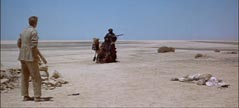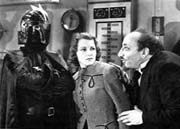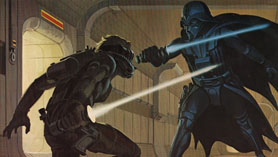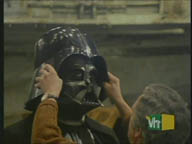|

Home

FAQ

The Book

Articles

Links

Contact

|
|
The Visual Development of Darth Vader
In The Secret History of Star Wars, a crucial focus
is the development and transformation that the character of Darth
Vader undergoes. This process was described mostly in relation to
the story itself, focusing mainly on his characterisation, however
at times it was necessary to dwell upon his visual design as a way
of drawing parallels to the story function; for instance how his
armored space suit was eventually "retconned" to be made into a
life-support device. Here, however, I wish to talk in more
explicit detail about the visual aspect, and actually show
this developmental process where possible. Here we'll examine the
early concept art, the creation of the costume and the subtle but
significant visual changes that slowly were wrought as the character
and story changed.
In the first draft, Darth Vader is fairly inconsequential,
and is merely an Imperial General; most of his later traits are
exhibited instead by Prince Valorum, a Sith Lord who dresses in
black robes and who speaks in terse, no-nonesense phrases. Both of
these characters are human and generally unremarkable in the visual
sense; no artwork was ever done. In draft two, however, the two
characters were combined, and this is where the Darth Vader that we
are familiar with first becomes recognizable in prototype form.
Ralph McQuarrie had been hired to do sketches and paintings by this
point, and one of the very first characters he tackled was Darth
Vader, who is a highly memorable part of the opening sequence of the
second draft script. In that version, Imperial forces capture and
board a ship, much like the opening of the final film, with Vader
and the stormtroopers decending onto the craft and engaging in
battle. The notable deviation is that Deak Starkiller takes the role
of Leia, and he faces Darth Vader in a lightsaber battle before
being defeated and taken prisoner.
McQuarrie's earliest sketches depict a man similar to Valorum
or General Vader from the first draft, being tall and with a flowing
cape, however a distinguishinig feature is that the character wears
what looks like a sort of futuristic gas mask over his face.
McQuarrie explains that it is a personal respirator, because the
character had to cross through space from the Imperial Stardestroyer
to the rebel cruiser. "Early in the script there was a description
of Vader crossing between two ships in space so I created
this mask so he could breathe in space," McQuarrie explains. "George
loved it." (i)
Hence we have the earliest depiction of Vader, now with a
personal respirator courtesy of McQuarrie.
   
It appears that McQuarrie began such sketches while Lucas was
in the midst of writing the second draft, because the character is
described in that script as wearing the respirator mask that
McQuarrie first sketched here. Following this, McQuarrie made a
number of alterations at Lucas' request. The robes became more
exaggerated, and the character was requested to have a wide-brimmed
samurai helmet, which McQuarrie combined with his respirator to
create a fearsome face-mask which completely obscured the
character's face.
  
This version is very reminiscent of a bedouin warrior,
especially prevelant in the first image above, and stems from the
opening sequence of the 1974 rough draft. In that scene the
Starkillers are hiding out on a barren desert planet when they
discover a Sith spacecraft has tracked them. They panic and begin
readying for a battle, but find no sign of the warrior. Suddenly,
a Sith knight appears and kills one of the young sons; the Sith
wears a facemask and is dressed in black robes. That scene and
the initial bedouin design is likely based on a memorable
scene from Lawrence of Arabia, a film that Lucas compared
Star Wars to more than once in 1974. In that classic film's
most gripping and strangely alien scene, P.T. Lawrence and his guide
trek across the desolate Arabian desert and stop at a well. The
guide senses something is wrong and a figure appears on the horizon,
slowly coming into view as a black-robed figure riding atop a
decorated camel. The guide panics, knowing they will be killed but
before he can retrieve his pistol the distant figure fires and kills
him. The bedouin figure reaches Lawrence and dismounts his
black-adorned camel, revealing him as deadly and
masked.
  
McQuarrie thought that Vader would look more menacing if he
was robed and armored, and so his next sketches reflected
this more futuristic design. Lucas also provided McQuarrie with
comic books and 1930s pulp fiction material to help steer the visual
design. One of his earliest designs in this new version had
Vader linked more directly to the stormtroopers, wearing a prototype
stormtrooper helmet.

With the more angular and science-fiction-based military look
of the new armored version of Vader, McQuarrie also made reforms to
the mask, extending the face-grill into a longer "snout" and
exagerating the eyes.
   
This version shows the influence of the comic book and serial
references Lucas provided McQuarrie, namely those of Doctor Doom,
from The Fantastic Four, and The Lightning, from the 1930s
Fighting Devil Dogs serial. Doctor Doom remains as a
popular villain and so his similarities are generally
well-known:
  
The villain Darkseid from another Jack Kirby series,
1973's The New Gods, also bears a strong
resemblance:
 
The Lightning however, remains more obscure, but a startling
similarity is present which surpasses even the Doctor Doom
influence:
  
With the Darth Vader design more or less decided upon with
the sketches shown a moment ago, McQuarrie decided that it was time
to depict the character in a full-colour painting. He chose the
lightsaber battle with Deak Starkiller. Because McQuarrie gave Vader
a respirator to allow the character to survive in the vaccum of
space, first when he crossed to the ship and then during the scene
itself where the hull was blown open, Deak also had to be provided
with a respirator, since the lightsaber battle took place in the
vaccumized corridor. Thus, we get the final production painting,
depicting the two masked characters squarring off with
lightsabers.

In draft two the character of Darth Vader only had two
scenes--the opening described above and then the final space battle
where he is killed--but since McQuarrie had designed such an
impressive villain, Lucas expanded the character with much more
screentime for the third draft. The mask, of course, was not a
permanent fixture, since it was merely a respirator for the opening
sequence--in one scene, Vader is explicitly shown to have removed
it, and drinks casually from a flask. The frightening helmet would
only be seen in the opening sequence, and likely at the final
space-battle sequence when Vader pilots a craft; for the rest of the
film, on the Death Star, the character would simply be portrayed by
the face of whatever actor was cast in his role.
However, in the fourth draft, Lucas decided that the
character would be more effective if he wore the space suit
throughout the length of the film. This act, however, made the suit
seem as though it were a permenant encasement of some kind. Lucas
had come up with the concept of The Duel by that point--Darth had a
duel with his former master, Obi Wan, and falls into a volcano,
scarring him so disturbingly that he must hide his features with the
mask, much like Doctor Doom. "His face is all horrible inside,"
Lucas says in 1977. "I was going to shoot a close-up of Vader
where you could see the inside of his face, but then we said no, no,
it would destroy the mystique of the whole thing." (ii) In the film,
the helmet was merely a decorative piece, doubling as a space suit/
respirator. Here we see the helmet being slipped onto actor David
Prowse, comprising of two pieces, one being the frontal mask and
then a second piece for the flarred brim:

   
The suit was meant to be a well-worn armored space suit,
which Vader had decorated with his Sith robes which cover much of
the armor. The costume even has scuff marks and a dull finish, being
part of the "used universe", indicating that Vader has had his suit
for a while now and has seen a lot of action with
it.
   
However, the character and his design function underwent a
crucial transformation after the picture was shot. Ben Burtt, sound
designer, came up with a cold, mechanical breathing sound that was
constant and rythmic--the result was that Vader appeared cybernetic
in his presentation. Lucas liked this idea, and in the experimental
mixes Burtt took this concept even further, adding robotic servos
and experimenting with more labored breathing sound effects--the
weak rasping that Vader exhibits at the end of Return of the
Jedi as he is about to die is, in fact, a rejected variation
from Star Wars. Says Burtt: "The original concept i had of
Darth Vader was a very noise-producing individual. He came in
to the scene, he was breathing like some queezing windmill, you
could hear his heart beating, he moved his head [and] you heard
motors turning, and he was almost like some kind of robot in some
sense. And he made so much noise that we sort of had to cut back on
that concept. In the first experimental mixes we did in Star
Wars, he sounded like an operating room, you know, an emergency
room, you know, moving around." (iii)
Lucas had come up with a reformation of the back story, now
developing that Darth Vader was so injured in his volcano duel that
he was encased in the suit to save his life, with the suit now a
mobile life-support device, and that much of his body had been
destroyed and rehabilitated cybernetically. This concept, of a
character having his limbs and organs replaced with cybernetics, was
a concept which Lucas had put into every single ealier draft of
Star Wars except for the final; now he had a chance to
bring it back. For the sequel, Empire Strikes Back, Darth
Vader was given a very subtle make-over to reflect this new cyborg
angle.
To start, the eyes were coloured pitch dark, as opposed to
Star Wars , where they were tinted a dark red and became
translucent when viewed at certain angles (see the previous
photos).Next, his armored breastplate was moved on top of the inner
robes instead of behind them, emphasizing the armor and giving a
slightly more robotic look.
  
His control box was also significantly overhauled. In
Star Wars it was merely a device to control his respirator,
and was fastened with straps similar to the ones the Rebel pilots
use on themselves for similar space-travel related matters. For
Empire, the box was instead more integrated into Vader's
body, and the "coin slots" were re-designed so as to look more
high-tech. Finally, blinking lights and LEDs were added. The same
facelift was given to the electronic devices on his
belt.
  
All of these changes made Vader seem more high-tech, more
electronic. Finally, one of the more obvious facelifts was the
finish of his costume. In Star Wars it was a well-worn
armored space suit but now it was a sophisticated life-support
device, and thus it was made slick and shiny, polished and
clean.
   
The voice of Darth Vader also underwent a change. In Star
Wars Ben Burtt gave James Earl Jones' voice a special
processing or "flanging" to make it seem muffled and processed
inside the helmet, but for Empire this was abstracted even
more, with a more prominent "electronic" flange and a much deeper
sound, both of which were emphasized by Jones' robotic
performance (as opposed to Star Wars, where he is quite
expressive). It has also been said that Lucas did not want the
character to sound "black" and so James Earl Jones' performance in
Star Wars is much higher-pitched so as to sound more
"neutral"; in the sequels, Jones' natural baritone would be
used. Click
here to listen to a comparison.
Finally, the world was given a brief glimpse of the man
underneath the helmet. "I shot this scene very carefully," director
Irvin Kershner says. "When the captain comes in and Vader is
sitting in his capsule with his back towards us, all you see are
scars on the back of his neck for a second. I didn't want the
audience to see anything else. I imagined that beneath the mask
Vader was hideous; his mouth was cut away and he had one eye hanging
low." (iv) Production art would be produced for Vader's hideous face
during the making of Return of the Jedi that reflects this
depiction, but as Kershner describes above, it was decided that
"less is more" and the character is seen only from
behind.

This brief glimpse was also meant to show that, indeed, there
was a human being underneath the suit, in order to give more
credence to the "Big Reveal" at the end of the
film.
A thorough examination of this fleeting moment reveals an
interesting fact which has gone virtually unreported: Vader sits
assisted by machinery, and although the robotic arm that lowers his
helmet into place is obvious, what is less obvious is that there is
a second robotic arm which is retracting an external
respirator. Shadows of the Empire developed that this
chamber was a "hyperbaric" medical chamber that allowed Vader to
breathe without his mask but this is based on an inaccurate reading
of the original scene. For starters, the egg-shaped chamber is
open when Captain Piet enters--is Vader holding his breath?
Shadows addressed this weird inconsistency by imagining
that Vader is experimenting with how long he can survive in an
"open" environment. The original scene gives us an alternate
perspective, instead showing us that Vader has merely removed his
helmet but still must rely on an external artificial breathing
device to survive (the chamber itself is only referred to as a
"meditation" chamber in the script). Piet enters, disturbing Vader,
and the external respirator retracts away and his helmet is lowered.
Below are screencaps of the scene, which give us only a brief
glimpse of the external respirator device (hint: it's the conical
instrument which is retracting behind the helmet).
   
  
A photo from the set reveals the external respirator in full
view. It is visible in its retracted form on the upper left side of
the chamber:

This external respirator originates from the script itself,
which specifically describes this detail. From the shooting
script:
Admiral Piett steps into the room and pauses at
the sight of...Darth Vader, his back turned, is silhouetted in the
gloom on the far side of the chamber. A black, insect-looking droid
attends him. Among the various apparatus surrounding them, a
respirator tube now retracts from Vader's uncovered head. The head
is bald with a mass of ugly scar tissue covering it. The black droid
then lowers Vader's mask and helmet onto his head. When it is in
place, he turns.
Return of the Jedi gave us some slight modifications
as well, notably a further enhancement of the vocal flanging to make
it seem more processed and electronic than in Empire Strikes
Back, perhaps because the unmasking scene at the end would
reveal a design that shows that Vader's natural voice is processed
and amplified through an electronic system. The unmasking scene
required more development be done on Vader. Since making Empire
Strikes Back , Lucas had decided to turn Vader from a villain
into a sympathetic character, unmasking and redeeming him in the
final drafts. Because he was no longer a hideous monster, he was
re-written as a "softer" and more human character--one early draft
had him scarred and with a cloudy eye and a grey beard, but for the
final version he was turned even more sympathetic, presenting him as
a pale old man. This unmasking scene also necessitated a more
elaborate design of the helmet. It is revealed to actually be three
pieces,with the third piece being the actual mouthpiece which
vocalises Vader's speech and processes his breathing. The cybernetic
aspect is emphasized once again, with all sorts of vents, buttons
and technological pieces decorating the helmet. Below is the prop
used in this scene:
 
Contrast that with the crude and simple two-piece mask used
in Star Wars. Lucas also gave us insight into the extent of
Vader's internal cybernetic re-construction--as Vader is being
electrocuted, his skeleton is made visible, revealing his legs and
arms to be fully or partially robotic, and his neck vertebrae to be
artificial, perhaps explaining his respiration dependence as due to
complete paralysis. Dr. Curtis Saxon has made an insightful
commentary on this aspect. Below are screencaps provided by him
which illustrate these things:
   

Finally, when it came to making Revenge of the Sith,
Lucas had to make specific choices regarding these elements
that were previously only hinted at. Firstly, it was
revealed that all of Anakin's limbs are artificial. Secondly, Anakin
suffered no such paralysis in his "volcano" tumble, and in fact he
is quite easily capable of breathing on his own, whether it is when
he is clawing his way up the Mustafar slope or when it is in the
medical chamber. It is strange that the film completely ignores this
"iron lung" aspect, which was originally the very impetus of the
whole cybernetic transformation. The novelisation, however, states
that Anakin's lungs were destroyed by breathing in the harmful
super-heated gases (one has to wonder why Obi Wan and Padme suffered
no such side effects despite only slightly less extreme
exposure). In the film, a large gap exists between the
scene where the medical droids begin work on him and the next time
we see him, where he is more or less completed and already in the
suit. Such a huge jump in time makes it seem as though Anakin has
neither any respiratory needs, nor has any integral cybernetic
enhancements to his organs or tissues, contrary to
what Return of the Jedi implies. The emphasis is
instead placed on his horrible imprisonment, reflecting the "tragic"
view of Vader that the prequels show. We do, however, get a brief
glimpse of the inside of the helmet, showing us high-tech HUD
displays and a red-tinted electronic perspective (similar to
Terminator). Lucas had to also make a decision on how to
visually portray the Vader suit. Rather than making a choice with
chronological consistency in mind, in other words going with the
suit shown in Star Wars, Anakin was instead given the
cyborg-emphasized design of the later two sequels. This design was
given even more robotic overtones however--the hand-sculpted mask of
the original films was remade using a robotic tool to ensure the
mask was perfectly symmetrical. The chestbox was now made to be
fully integrated into Vader's torso, creating a cyborg
look. Finally, the helmet was made to connect
underneath the breastplate, instead of overlapping on top
as it did in the original films--this subtle but effective re-design
gave Vader a more robotic look.
  
Finally, Star Wars was altered where possible to
match the depiction seen in the subsequent entries--James Earl
Jones' voice was enhanced for the 2004 DVD release to sound more
like the electronic version of Empire Strikes Back,
Return of the Jedi and Revenge of the Sith
.
For those wishing to know more detail about the costume
itself, Darth Blade's Vader
costume site is a great source of information, a truely
meticulous study on the Vader costume and its many variations used
in the films.
The Star Wars Technical Commentaries also has a very
well-researched article on The Injuries of
Darth Vader.
Dr. Saxon has also taken a look at the writing
inscribed on Vader's chestbox. A popular theory, one that Dr.
Saxon here tries to address, is that the writing is Hebrew and
speaks of sin and redemption. If that sounds a bit at odds with the
character depicted in the 1977 film, this is not surprising--more
recently, the leading theory has come about that the writing does
not say anything at all. Rather, it is merely a jibberish statement
which uses Hebrew as the basis due to its "alien" aesthetic
qualities (in a similar way that Huttese is based on real life
languages). "Darth Blade's" Vader costume page has a thorough debunkment of this
myth.
End Notes:
(i) The Best of the Lucasfilm Archives by Mark Cotta Vaz and
Shinji Hatta, 1994, p. 14
(ii) Rolling Stone, August 25th, 1977
(iii) Empire Strikes Back Definitive Edition Laserdisk
Interview, 1993
(iv) Annotated Screenplays, 1997, p. 165
04/02/07
All images are copyright Lucasfilm. They are
used under the rights of fair use for educational purposes
Web site and all contents © Copyright Michael
Kaminski 2007, All rights reserved.
Free
website templates |
|